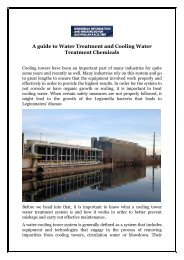What Fosters The Growth Of Cooling Tower Legionella
The deadly Legionnaire’s disease comes under the category of pneumonia. In this condition, the lungs are inflamed acutely, mostly due to an infection. In the Legionnaire’s disease, this condition is caused by the Legionella bacteria.
The deadly Legionnaire’s disease comes under the category of pneumonia. In this condition, the lungs are inflamed acutely, mostly due to an infection. In the Legionnaire’s disease, this condition is caused by the Legionella bacteria.
Create successful ePaper yourself
Turn your PDF publications into a flip-book with our unique Google optimized e-Paper software.
<strong>What</strong> <strong>Fosters</strong> <strong>The</strong> <strong>Growth</strong> <strong>Of</strong> <strong>Cooling</strong> <strong>Tower</strong> <strong>Legionella</strong>?<br />
<strong>The</strong> deadly Legionnaire’s disease comes under the category of pneumonia. In<br />
this condition, the lungs are inflamed acutely, mostly due to an infection. In<br />
the Legionnaire’s disease, this condition is caused by the <strong>Legionella</strong> bacteria.<br />
This is not a contagious disease that can spread through touch, but instead a<br />
person catches the legionnaire’s disease through inhaling a water droplet<br />
small enough to enter their system. This water droplet is infected by these<br />
bacteria, which enter into the lungs and then cause this disease. A major cause<br />
of this disease is the bacteria that thrive in the cooling towers. Due to this<br />
cooling tower legionella, a lot of industry workers contract this disease.
A lot of people develop early symptoms for this disease. <strong>The</strong>se include flu like<br />
condition such as chills, fever, nausea, diarrhoea, muscle pain, headaches etc.<br />
Other symptoms include, that the patient may develop later, shortness of<br />
breath, mental changes, chest pain etc. Over time, the person may suffer from<br />
respiratory failure, kidney failure and sudden blood pressure drop, thus,<br />
making the disease fatal.<br />
One of the greatest risks of <strong>Legionella</strong> virus is faced when cooling towers<br />
contain water that is untreated for several weeks. As the bacteria need a warm<br />
and moist climate to grow, these conditions in the cooling towers, where the<br />
water remains dirty and stagnant, prove congenial for its growth. This is a<br />
grave condition to work in, and can specially affect the elder staff that is<br />
working in your company, somebody with respiratory problems, diabetic<br />
people or heavy smokers and drinkers. <strong>The</strong>refore, it is essential that the<br />
company should take care of the condition of water in their cooling towers.<br />
<strong>Cooling</strong> towers are the perfect grounds for bacteria growth as they are open<br />
and contain warm water. <strong>The</strong>y are built on the principle of evaporating the<br />
water and also diffusing heat by giving out a mist of warm water through a top<br />
corner. This mist definitely contains the water droplets that are infected. If<br />
there are any open windows or inlets near to the tower, these droplets enter<br />
into the spaces inhabited by people and thus, are inhaled by them through<br />
aspiration. This is where it all starts.<br />
This can readily be reduced if the industries follow the practices of installing,<br />
operating and maintaining the water systems properly. <strong>The</strong>se cooling towers<br />
need disinfecting ever now and then, and the water in the towers must be kept<br />
at temperatures that do not encourage the growth of these bacteria. Treating<br />
the towers with biocides is another way of preventing legionella growth. <strong>The</strong><br />
metal surfaces should be trated with these, so that any other growth, perhaps<br />
of alga can be removed. Any contamination must be treated immediately and<br />
the towers must be de-scaled. Corrosion is another factor that can lead to an<br />
increased growth of the bacteria. Corroded and worn out aged parts must be
eplaced at once. Weekly checks are necessary to maintain the health of the<br />
tower. <strong>The</strong>y must be constantly monitored and any abnormal growth must be<br />
reported.<br />
<strong>Legionella</strong> bacteria will definitely colonise if given the conditions that it needs<br />
to grow in population, but with some steps, particularly for the cooling tower<br />
legionella prevention, this situation can be abated. For more details, visit<br />
http://www.legionellaguidelines.com.au





